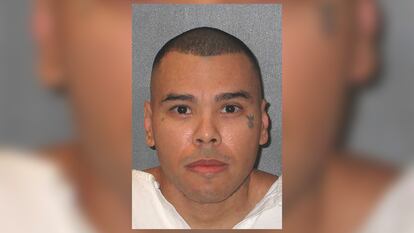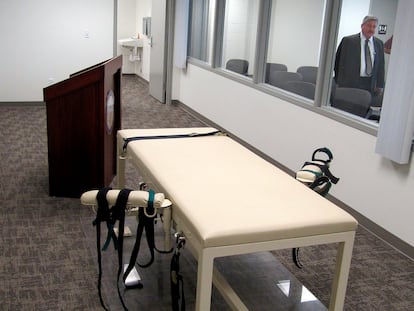Texas executes Ramiro Gonzales despite psychiatrist changing opinion on his ‘future dangerousness’
The doctor who helped send him to death row in 2006 for the murder of Bridget Townsend, later reversed his assessment, but the Supreme Court on Wednesday refused to stop the execution

The state of Texas on Wednesday night executed Ramiro Gonzales, a man who confessed to the kidnapping, sexual assault and murder of Bridget Townsend 23 years ago, in January 2001. Lawyers tried to stop Gonzales’s execution, making their last attempt just a few hours before the lethal injection. In all death penalty cases, and under Texas law, the jury must evaluate the “future dangerousness” of prisoners — i.e. the likelihood they will commit criminal acts in the future —, which determines whether they are sentenced to capital punishment or life imprisonment. The psychiatrist, who said that Gonzales posed a threat in 2006, recanted years later and admitted his error, but the Supreme Court on Wednesday refused to stop the execution.
At the 2006 trial, psychiatrist Edward Gripon testified that Gonzales would likely commit another sexual assault and maintained that he had raped Townsend for sexual gratification. Gripon considered him a poor candidate for rehabilitation. But as an investigation by The Marshall Project revealed, 15 years later, the doctor spoke with Gonzales again and changed his opinion: “Psychopaths will tell you it’s someone else’s fault,” Gripon told The Marshall Project. “Ramiro doesn’t try to lie his way out … If this man’s sentence was changed to life without parole, I don’t think he’d be a problem.” Although Gripon maintained that the convicted man was no longer a danger to society, the Texas court decided not to pardon him.
Townsend was 18 years old when Gonzales kidnapped her from a home northwest of the city of San Antonio. On Wednesday, the victim would have turned 41 years old. Patricia Townsend, her mother, told USA Today that she was pleased at the outcome: “When they told me [the execution was on] June 26, I started crying, crying, crying. That’s her birthday.”
After kidnapping the 18-year-old, according to court documents, Gonzales took the young woman to his family’s ranch in a neighboring county, sexually assaulted her and shot her to death. Then he hid her remains. Authorities found the body two years later, when Gonzales himself confessed to the crime while facing two life sentences for the kidnapping and rape of another woman.
Gonzales’ defense team has been trying for years to stop his execution by pointing to his good record in prison, his dedication to the Christian faith and his attempts failed to donate a kidney to a stranger. The defense argued that the inmate was no longer a danger to society, and said that the Texas Court of Criminal Appeals had violated Gonzales’ constitutional rights by refusing to review the erroneous statements of the prosecutor’s medical examiner, Dr. Gripon.
The lawyers appealed to the United States Supreme Court to stay the execution and explained that the prisoner was 18 years old when he committed the crime and that he had had a traumatic childhood: they noted that Gonzales’s mother consumed alcohol during her pregnancy and that she had been sexually abused as a child. The defense presented a series of studies that proposed raising the age of eligibility for the death penalty from 18 to 21, based on brain development.
In a video released on Wednesday, hours before the injection, Gonzales sent a message: “I just want (Townsend’s mother) to know how sorry I really am. I took everything that was valuable from a mother.” David Townsend, the victim’s brother, has criticized attempts to portray Gonzales as anything other than a convicted murderer who committed “unforgivable acts.”
This is the second execution to take place in Texas so far in 2024. The southern U.S. state killed Iván Abner Cantú last February for the murder of two people in Dallas. Oklahoma is planing another execution soon, meaning there would be two in just one week in the U.S. Nine executions have been carried out in this year alone, according to data from the Death Penalty Information Center, a nonprofit organization that provides the media and the public with information about capital punishment in the country.
The fight to overturn Gonzales’ conviction lasted years. The prisoner previously asked for a stay on his execution to donate one of his kidneys to a member of his religious congregation, but his blood type was not compatible with that of the potential recipient. Additionally, a group of religious leaders sent a letter to Texas Governor Greg Abbott asking him to spare Gonzales’ life and allow him to spend the rest of his life serving other detainees. But these efforts were in vain.
Gonzales received the lethal injection at the state penitentiary in Huntsville at 6:50 p.m. “I can’t put into words the pain I have caused you all, the hurt, what I took away that I cannot give back. I hope this apology is enough,” he said from the execution chamber.
Sign up for our weekly newsletter to get more English-language news coverage from EL PAÍS USA Edition
Tu suscripción se está usando en otro dispositivo
¿Quieres añadir otro usuario a tu suscripción?
Si continúas leyendo en este dispositivo, no se podrá leer en el otro.
FlechaTu suscripción se está usando en otro dispositivo y solo puedes acceder a EL PAÍS desde un dispositivo a la vez.
Si quieres compartir tu cuenta, cambia tu suscripción a la modalidad Premium, así podrás añadir otro usuario. Cada uno accederá con su propia cuenta de email, lo que os permitirá personalizar vuestra experiencia en EL PAÍS.
¿Tienes una suscripción de empresa? Accede aquí para contratar más cuentas.
En el caso de no saber quién está usando tu cuenta, te recomendamos cambiar tu contraseña aquí.
Si decides continuar compartiendo tu cuenta, este mensaje se mostrará en tu dispositivo y en el de la otra persona que está usando tu cuenta de forma indefinida, afectando a tu experiencia de lectura. Puedes consultar aquí los términos y condiciones de la suscripción digital.
More information
Archived In
Últimas noticias
Most viewed
- Reinhard Genzel, Nobel laureate in physics: ‘One-minute videos will never give you the truth’
- Oona Chaplin: ‘I told James Cameron that I was living in a treehouse and starting a permaculture project with a friend’
- Pablo Escobar’s hippos: A serious environmental problem, 40 years on
- Why we lost the habit of sleeping in two segments and how that changed our sense of time
- Charles Dubouloz, mountaineering star, retires at 36 with a farewell tour inspired by Walter Bonatti










































